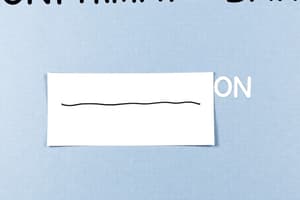Podcast
Questions and Answers
What does confirmation bias prevent individuals from doing?
What does confirmation bias prevent individuals from doing?
- Changing their opinions based on statistical data
- Evaluating all available evidence impartially (correct)
- Accepting new beliefs based on personal experiences
- Recognizing the influence of their prior beliefs
In the context of Bayes' Rule, what does P(B) represent?
In the context of Bayes' Rule, what does P(B) represent?
- The probability of the belief being true after seeing the evidence
- The prior belief before seeing the evidence (correct)
- The probability of having evidence A
- The probability of the evidence given the belief
What characterizes the strong priors of a climate denier and climate scientist in the context of Bayes' Rule?
What characterizes the strong priors of a climate denier and climate scientist in the context of Bayes' Rule?
- Both exhibit biases towards confirming their beliefs
- Both have probabilities of P(B) that are very close to 0 or 1 (correct)
- Their beliefs about climate change are formed through identical evidence
- Both have equally high probabilities for P(B)
What type of questions motivates the study of how people assess probabilities?
What type of questions motivates the study of how people assess probabilities?
According to Kahneman and Tversky's work, what is a common challenge individuals face with probabilities?
According to Kahneman and Tversky's work, what is a common challenge individuals face with probabilities?
What does the notation $P(B|A)$ refer to in Bayes' Rule?
What does the notation $P(B|A)$ refer to in Bayes' Rule?
What is a consequence of confirmation bias on decision making?
What is a consequence of confirmation bias on decision making?
How might biases influence probability assessments according to behavioral economists?
How might biases influence probability assessments according to behavioral economists?
What does the variable α represent in the projection bias model?
What does the variable α represent in the projection bias model?
In the context of overconfidence, what was a common finding about self-rating for driving safety among college students?
In the context of overconfidence, what was a common finding about self-rating for driving safety among college students?
Which statement accurately reflects the relationship between the rational model and the projection bias model?
Which statement accurately reflects the relationship between the rational model and the projection bias model?
What can be inferred about the self-ranking results in the experiment regarding perceived driving skill?
What can be inferred about the self-ranking results in the experiment regarding perceived driving skill?
How is the utility of consumption defined in relation to the state in projection bias?
How is the utility of consumption defined in relation to the state in projection bias?
What was a significant shift in thinking introduced by Kahneman and Tversky regarding probability assessments?
What was a significant shift in thinking introduced by Kahneman and Tversky regarding probability assessments?
Which assumption is part of von Neuman and Morgenstern's expected utility theory?
Which assumption is part of von Neuman and Morgenstern's expected utility theory?
How do Kahneman and Tversky view the subjective nature of probability assessments?
How do Kahneman and Tversky view the subjective nature of probability assessments?
What is the primary focus of Kahneman and Tversky's research?
What is the primary focus of Kahneman and Tversky's research?
Which of the following describes the representativeness heuristic?
Which of the following describes the representativeness heuristic?
What is an example of a bias resulting from the representativeness heuristic?
What is an example of a bias resulting from the representativeness heuristic?
What type of sample size was typically used in Kahneman and Tversky's experiments?
What type of sample size was typically used in Kahneman and Tversky's experiments?
What do the availability heuristics primarily rely on?
What do the availability heuristics primarily rely on?
How did the methods used by Kahneman and Tversky differ from traditional economic research methods?
How did the methods used by Kahneman and Tversky differ from traditional economic research methods?
What is the ratio expected between the assessments of the two treatments based on Bayes’ Rule?
What is the ratio expected between the assessments of the two treatments based on Bayes’ Rule?
What cognitive bias is displayed when subjects ignore base rates in probability assessments?
What cognitive bias is displayed when subjects ignore base rates in probability assessments?
When presented with Linda's case, what incorrect conclusion do most individuals tend to draw?
When presented with Linda's case, what incorrect conclusion do most individuals tend to draw?
How does the availability heuristic affect the assessment of the national divorce rate?
How does the availability heuristic affect the assessment of the national divorce rate?
In the word selection example, what is the more likely occurrence when selecting a random word?
In the word selection example, what is the more likely occurrence when selecting a random word?
What result did KT find concerning undergraduates' responses to Linda's description?
What result did KT find concerning undergraduates' responses to Linda's description?
Which is NOT an example of availability bias?
Which is NOT an example of availability bias?
What might cause subjects in the experiment with the vignette to offer a ratio close to 1 instead of 2.33?
What might cause subjects in the experiment with the vignette to offer a ratio close to 1 instead of 2.33?
What is a limitation of using the availability heuristic?
What is a limitation of using the availability heuristic?
What factor appears to influence purchasing behavior for winter gear according to the findings?
What factor appears to influence purchasing behavior for winter gear according to the findings?
What is the primary explanation for increased sales of convertibles during warmer weather?
What is the primary explanation for increased sales of convertibles during warmer weather?
In the context of housing purchases, how does seasonal weather affect prices?
In the context of housing purchases, how does seasonal weather affect prices?
What does standard economic theory suggest about utility maximization?
What does standard economic theory suggest about utility maximization?
What is a potential economic consequence of purchasing behavior influenced by colder temperatures?
What is a potential economic consequence of purchasing behavior influenced by colder temperatures?
According to the analysis of vehicle purchases, what effect does a snowstorm have on vehicle types sold?
According to the analysis of vehicle purchases, what effect does a snowstorm have on vehicle types sold?
What does a utility function demonstrate in economic theory?
What does a utility function demonstrate in economic theory?
What is indicated by the term 'projection bias' in relation to purchasing behavior?
What is indicated by the term 'projection bias' in relation to purchasing behavior?
How does temperature impact the purchase of cars according to the data analyzed?
How does temperature impact the purchase of cars according to the data analyzed?
What is implied about the relationship between weather and consumer behavior in the studies discussed?
What is implied about the relationship between weather and consumer behavior in the studies discussed?
Flashcards are hidden until you start studying
Study Notes
Biases and Heuristics
- Confirmation bias involves favoring information that supports one’s existing beliefs while disregarding contradictory evidence.
- Bayes’ Rule illustrates how prior beliefs (P(B)) and new evidence (P(A|B)) update beliefs (P(B|A)), leading to differing interpretations of evidence between individuals with strong prior beliefs.
- Examples include climate deniers and scientists having differing views on climate change despite seeing the same evidence due to their strong priors.
Kahneman and Tversky (1974)
- Probability assessments impact everyday decisions, such as forecasting inflation or job prospects.
- Questions arise about how individuals assess probabilities and whether these assessments adhere to traditional probability theory.
- Traditional economic research relied on the assumption that people can easily calculate probabilities, as per Bayes' Rule and expected utility theory.
- Kahneman and Tversky emphasized subjective probability assessments and highlighted heuristics over classical probability methods.
Heuristics
- Heuristics are simplified decision-making rules that can be rational or biased, depending on the context.
- Three key heuristics identified by Kahneman and Tversky are representativeness, availability, and anchoring.
Representativeness
- The representativeness heuristic judges probabilities based on how typical or representative an individual is of a category.
- An experiment showed that people ignore base rates (e.g., proportion of engineers vs. lawyers) and instead rely on how representative a description matches a stereotype, leading to base rate neglect.
- The Linda problem illustrated that people erroneously assess the likelihood of a more specific scenario (active feminist bank teller) as more probable than a general one (bank teller), defying probability theory.
Availability Bias
- The availability heuristic assesses event probabilities based on how easily examples come to mind, which can sometimes lead to distorted perceptions.
- An example demonstrated that people misjudge the likelihood of a word selection from a dictionary based on their recollection rather than actual frequency (beginning vs. third letter).
- Evidence from purchasing behaviors showed effects of weather on buying habits, suggesting that current conditions distort memory recalls and decisions (e.g., increased sales of convertible cars in warm weather).
Projection Bias
- Connections between abnormal weather and large purchases (cars and houses) indicate that people’s current states influence future preferences.
- In a study, results indicated that warmer temperatures heightened the sale of convertibles and snowstorms influenced all-wheel-drive vehicle purchases.
- A utility function describes consumer preferences, with the aim to maximize utility from different options.
Overconfidence
- Overconfidence was illustrated through a study where college students inaccurately rated their driving skills and safety, with most rating themselves above average—a statistical improbability.
- Possible causes for overconfidence include a reluctance to reveal weaknesses and differing interpretations of what constitutes driving proficiency.
Studying That Suits You
Use AI to generate personalized quizzes and flashcards to suit your learning preferences.




